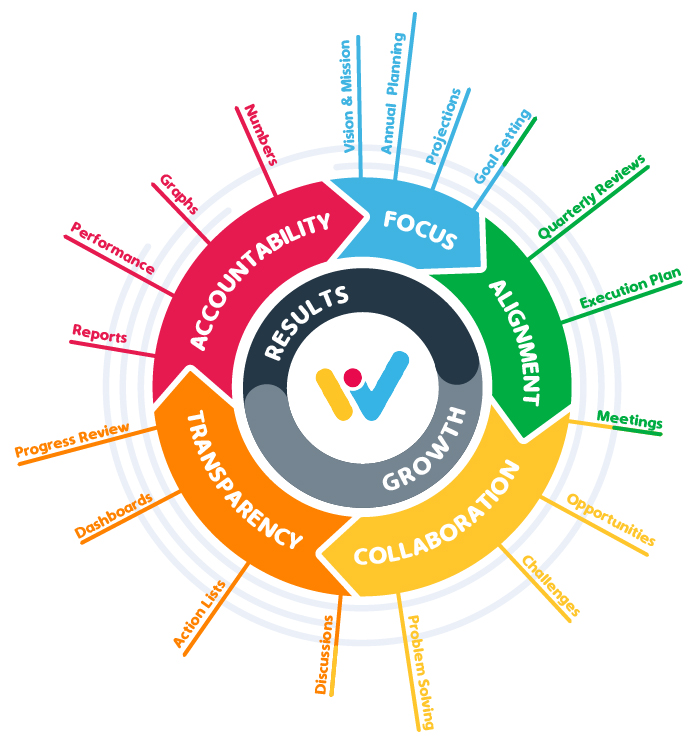
GOAL | PLANNING | TEAM ALIGNMENT | OKR | KPI | SMART
5 Common Goal-Setting Mistakes and How to Overcome Them in 2022
5 Common Goal-Setting Mistakes and How to Overcome Them in 2022
 Catherine Lethbridge
Catherine Lethbridge
Published 28/11/2021
Goal setting increases the likelihood of success for individuals (Forbes). The saying goes for businesses too. However, doing it right is a different story. Too often, goals are set top-down with little integration across teams and departments. This is a mistake. Engaging an entire organisation to work towards common goals requires commitment from every team, but commitment comes with meaning. According to a recent McKinsey report, one of the top five priorities CEOs are concerned with is ensuring that their company is operating with purpose. This can be done by setting company objectives that line up with their teams. So how do organisations achieve goal alignment?
There are multiple frameworks that help companies set goals, including the popular SMART goals, OKRs and KPIs. Some drive your organisation forward, while others hinder your teams’ efforts and send the business off-course. This article will explain the importance of goal setting and list well-known frameworks. We’ll share the five common pitfalls to avoid and what you can do to overcome them to start planning 2022 right.
. . .
Why is goal-setting important?
Goal setting is directly linked to task achievement rates and higher performance. Without a goal, you are “Going Rambling without a Destination”, as Taoist Zhuangzi once said. To reach your businesses’ full potential, you must master goal setting.
Here are five benefits to goal-setting:
Provide a direction and focus – the daily “busyness” and conflicting priorities of running a business often throw well-meaning intentions out the window. Setting goals and breaking them down into quarterly or monthly milestones provides direction, focus and a rhythm to achieve larger objectives.
Give meaning to work – no one wants to work for no reason. Setting goals and explaining the “why” are key to motivating teams and giving teams purpose to their work. More engaged teams drive a positive culture, better results, more productivity and a higher sense of gratification.
Clarify decision-making – self-doubt, challenges and opportunities happen in every business, and you must make decisions to remove turbulences or pursue new directions. Setting clear goals serves as a compass and helps drive the discussions to find an appropriate course of action.
Motivate teams – goal setting provides a challenge that energises teams to find solutions. Giving feedback on accomplishments encourages high performing teams to deliver and stretch themselves continuously.
Helps prioritise – running a business requires you to wear all the hats. Of all the activities you must take to reach your objectives, taking the time to link actions to goals is the only thing you must focus on. This self-sorting exercise helps you sift through the clutter and discard the non-critical steps you strive for.
. . .
What is a goal-setting framework?
Goal setting frameworks are structured approaches to defining objectives and measuring their progress. Adopting a suitable goal-setting framework is essential to any business planning because it serves as a reference, saving your company valuable time and effort into building your own. A good goal-setting framework should include a vision or mission statement, a strategy, a roadmap, and metrics. This gives your team clarity, keeps them on track, motivated and challenged.
Popular goal-setting frameworks
In business, there are four popular goal-setting frameworks that usually involve breaking down larger goals into smaller steps, linking objectives to actions, measuring performances and specifying delivery dates:
- MBO (Management by Objectives)
- KPIs (Key Performance Indicators)
- SMART goals (Specific, Measurable, Achievable, Realistic, Timeliness)
- OKR (Objectives and Key Results)
None of these frameworks is perfect, implementing them with a flexible approach will help you unlock the full potential of your goals. OKR is one of the most popular frameworks. However, developing OKRs can be complex, and without proper training or guidance, OKR can underdeliver on their promises. On the other hand, the traditional KPIs can be misused, creating more confusion about what is driving the business. The old school MBO is a top-down goal-setting framework that has been criticised for its rigidity, narrow focus on targets and no guidance on execution.
Adapt them to your business with the FACTA principles
We created the acronym FACTA to underpin business success, to keep goals and teams aligned to what matters. Adopt the FACTA principles to keep you on track with your goal setting and avoid the five common pitfalls listed below.
- Focus
- Alignment
- Collaboration
- Transparency
- Accountability

FACTA Principles
How to implement your goals
Pick the right software to implement your chosen framework to get your teams up and running fast with goal setting. In recent years, OKR software have increased in popularity and proven to drive team alignment and boost results. However, their quarterly planning and review frequency can be a little rigid for some companies which business cycle is different.
Learn how Kolsen Group transitioned to a more agile business review cycle since using Workfacta. Read the Case Study
. . .
5 common goal-setting mistakes and how to overcome them
While goal setting has many benefits, they can be undermined by common pitfalls. Here are the top five mistakes’ organisations make and how to address them by applying the FACTA principles.
Mistake #1 – your goals are made for individuals, not teams
When goals are set for individuals, they can fall short of meaning for the primary business objectives. The metrics used to measure individual performance don’t necessarily reflect how the business is tracking.
What you can do instead:
Promote a collaborative approach to setting goals, align your teams by setting goals together and periodically review their relevance. #Collaboration #Alignment #Focus
Mistake #2 – your goals are too rigid
Setting fixed goals to achieve an outcome is discouraging creative thinking from the onset. Experienced executives tend to rely on the problem-solving skills they acquired throughout their career – with due credits. However, this can lead them to be less inclined to learn new ways of producing the same results.
What you can do instead:
Build team agility and adaptive mindset into your organisation: be specific about the outcomes but allow some freedom in getting the same results. This will foster engagement and creativity from your top performers. #Collaboration #Alignment
Mistake #3 – your goals are unrealistic
There is value in setting ambitious goals. However, complex or over-stretched goals decided top-down by overconfident executives can demotivate teams.
What you can do instead:
Instil transparency by sharing your goal-setting process with the team, collect feedback. Periodically review the validity of these goals. Foster a collaborative approach to problem-solving to find better ways to achieve set targets. #Transparency #Collaboration #Alignment
Mistake #4 – your goals lack a structured execution plan
You wouldn’t go building a house without a plan, a schedule, and a good project manager. Executing a goal follows the same principle.
What you can do instead:
Assigning a project lead or a person accountable for each objective or task ensures that you have one point of contact whose primary focus is the goal’s success. Give guidance to your teams on problem-solving: consider a disciplined approach to resolving bottlenecks, challenges, opportunities, and discussions. #Accountability #Collaboration
Mistake #5 – you measure your goal progress wrong
Measuring how your goals are progressing is essential to ensure that you are on track. However, one of the biggest mistakes is to “copy” someone else’s metric, regardless of its relevance to your business. Sure, there’s no need to re-invent the wheel, and choosing well-known metrics can save you time, but do you measure what matters? Are you guilty of measuring everything and anything?
What you can do instead:
Don’t just pick a metric off-the-shelf but select the one relevant to you and your objectives. Re-assess their relevance periodically. Consider co-creating these metrics and make teams accountable for their own numbers. #Collaboration #Accountability #Transparency #Alignment
. . .
In conclusion: pick the best fit, but adopt flexible practices
The key: select the best fit for your team but adopt these flexible FACTA principles. Everyone in the team will gain clearer focus, improved alignment, increased collaboration, greater transparency, and better accountability.
Does your organisation require a flexible goal-setting tool? Not sure about which framework or tool to choose?
Start with Workfacta, an intuitive, agile goal-setting and execution platform suited for implementing OKR, SMART goals and KPIs frameworks.
Companies of all sizes and industries have chosen Workfacta to deliver
their annual plan and reported an increase in 65% in meeting their goals.
Learn more about how Workfacta can support your business goals. Contact us now for a chat or organise an obligation-free demo with our Workfacta expert.

